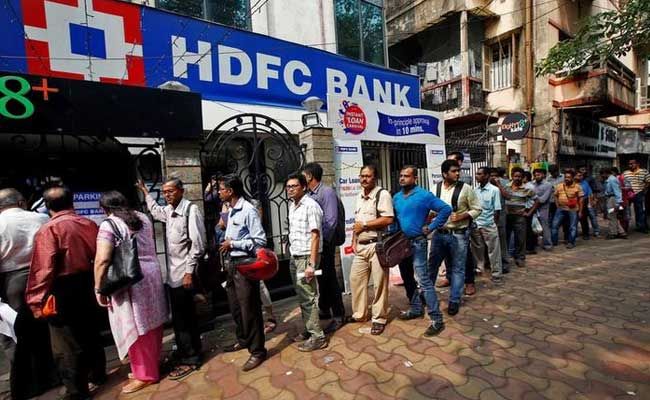Currency ban has caused immense hardship to poor people across the nation. While poor and lower middle class people are hardest hit by the demonetization of Rs 500 and Rs 1000 notes, the upper middle class and the super rich with billions of rupees in their Swiss bank accounts can enjoy the ongoing ‘surgical strike’ with complete derision and contempt.
These are the people who don’t need to stand in miles long queues for hours and return home without anything in their hands. Many a people, who saw their efforts go in vain during the day, tried their luck late night. But they too had the same luckless night as they had their days.
Rs 500 and Rs 1000 ban
Since the November 8 decision of the BJP government, people’s days are being used by entire families to stand in queues trying to get hold of that elusive money that they earned with sweat and blood for years. Now they are made to strive even harder to get hold of as small sums of money as Rs 4000 and Rs 2000 from banks and ATMs respectively.
People are standing in queues. When unsuccessful, their spouses are also joining them to just try their luck in case it is successful. A well-journalist with leading news magazine while writing his own experience says in a Facebook post, “Why should the guys with White money have to pay for the sin of those with Black money? I kept my patience when the PM announced the withdrawal of currency notes of Rs 500 and 100 denomination. I rushed to no bank, no ATM. But on the weekend, I went to ATMs in Noida, Ghaziabad, Patparganj, ITO, Connaught Place, Daryaganj, Kashmere Gate, Nizamuddin, Sundar Nagar and returned empty handed”.
It is not the end of his unsuccessful run at banks and ATMs. He goes on to add, “On Sunday my wife stood in a queue at a bank in Noida for eight hours. She wanted to withdraw a grand sum of Rs.10,000. At the end, around 7 pm the bank generously offered to give all those who had received a token before noon, two thousand rupees each. I repeated my search for cash from ATMs this morning. Returned empty handed again. Where, just where is my hard earned money? In childhood I was told by my parents that one should pay the labourer before his sweat dries. But nobody prepared me for a govt that will take away my cash after the sweat has dried!”
currency-recall
Here are hundreds of millions of people who have to endure the same pain, torture and agony. While almost everyone seems to be immensely affected by this rather ill-planned and very badly implemented demonetization of Rs 500 and Rs 1000 currency notes that made around 85 percent of all the currency notes in circulation, the worst affected are poor.
Here are five reasons why Dalits and poor from minority communities are going to be the worst affected by the whole farce called demonetization of Rs 500 and Rs 1000 currency notes.
1-Dalits and minorities are poorest of the poor
Dalits are poorest of the poor in the country. In eight Indian states alone there are more ‘multidimensionally’ poor people – about 421 million – than in the 26 poorest sub-Saharan countries in Africa combined. Poverty levels are highest among India’s tribal population (81.4 percent), followed by Dalits (65.8 percent) and Other Backward Classes (58.3 percent).
These are the people who have to strive hardest to earn their livelihood and now the sudden demonetization of currency has hit them the hardest. According to the NHRC statistics put together by K.B. Saxena, a former additional chief secretary of Bihar, 37 per cent Dalits live below the poverty line, 54 per cent are undernourished, 83 per 1,000 children born in a Dalit household die before their first birthday, 12 per cent before their fifth birthday, and 45 per cent remain illiterate. The data also shows that Dalits are prevented from entering the police station in 28 per cent of Indian villages. Dalit children have been made to sit separately while eating in 39 per cent government schools. Dalits do not get mail delivered to their homes in 24 per cent of villages. And they are denied access to water sources in 48 per cent of our villages because untouchability remains a stark reality even though it was abolished in 1955.
2-Dalits work as casual labors in the labor market
A disproportionately large number of Dalits work as casual labor. A World Bank report says, “We look at labor force participation rates (in self-employment, in regular jobs and in casual work) separately for men and women in rural and urban areas and find that overall Dalits are slightly more likely to participate in the labor force than non SC/STs. Dalit disadvantage really plays out in the kind of work Dalit men and women do when employed. Historically, Dalits have remained landless and while some states in India have implemented land reforms after independence this has not been the norm. This has meant a preponderance of Dalits in casual labor. From the NSS we find that, in 2004–05, over 41 per-cent of Dalit men and 20 percent of Dalit women were engaged in casual labor as opposed to 19 percent of non SC/ST men and 8 percent of non SC/ST women. Moreover, the decline from 1983 had been miniscule, when about 44 percent of SC men and 27 percent of SC women had been employed as casual labor.”
3-Dalits have hardly bank accounts
While many middle class families are able to go and get some cash from their bank accounts and ATMs. Dalits cannot just walk in and get cash from banks. An overwhelmingly large number of Dalits have their hard earned savings in the form of cash, mostly in Rs 500 and Rs 1000 denomination. Now with these two currency notes banned, the poor, landless Dalits cannot go to ATMs and get some much needed money to take essential food items, kerosene or medicines to home.
4-Large number of Dalits cannot fill up required forms
Though in Urban areas, this cannot be such a big issue, but in rural areas, this is impacting large number of people. As thousands of people stand in queues in every bank where currency notes are being changed, Dalits face an issue of their own. As large number of them can hardly read or write, they face immense trouble in filling up the form to change their own money that they bring along. Along with an ID proof everyone has to fill up a form before he could exchange a meager Rs 4000 (now Rs 4500) from bank.
5-Livelihood endangered as instead of working they stand in queues for getting cash
Their livelihood has been endangered as instead of working in their small kirana shops, as agriculture labor, working in some small office, their days and nights too are being spent in standing in long queues. Now not just they cannot get their own money converted into new currency notes, they too cannot earn their livelihood. As discrimination against Dalits runs deep in the Indian society there, are fears that many Dalits may be barred from standing in queues, precipitating the crisis for Dlit household across the country. The plight of the Dalits and other poor in states like Uttar Pradesh, Bihar, West Bengal, Chattisgarh, Jharkhand, Karnataka and Maharashtra is beyond imagination for others who have neither to endure the discrimination nor the poverty that they face.
———
(Courtesy : ViewsHeadlines.Com)






0 Comments